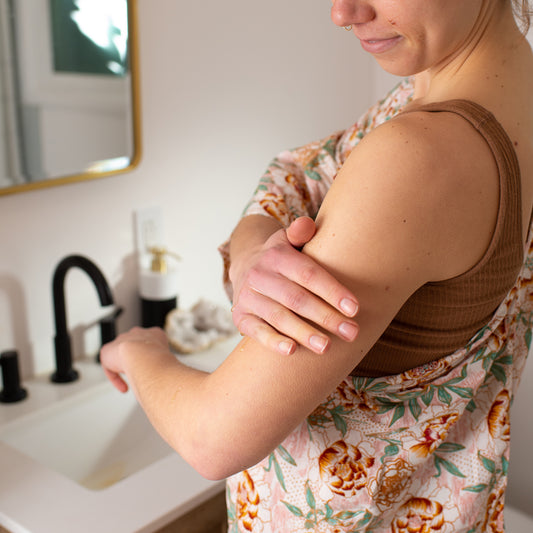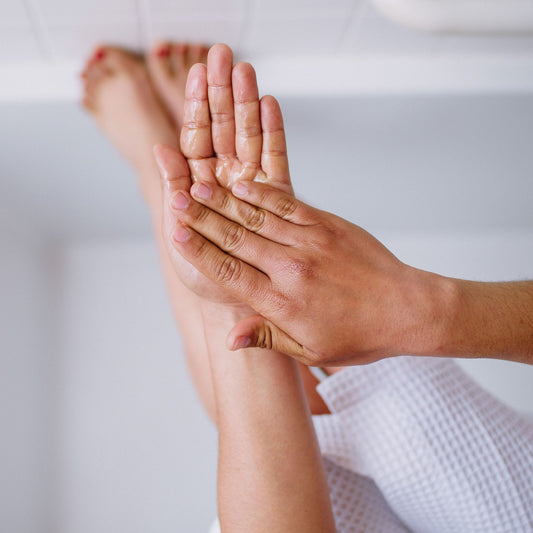Physical movement is a fun and effective way to stay healthy and balanced for all body types.
Yoga to Balance Vata
Common vata imbalances included anxiety, forgetfulness, and insomnia. It is important to ground vata energy, and when vata-types are grounded, they feel more supported by the earth. This support helps to calm the mind and nervous system.
Grounding Sequence
Child's Pose (Balasana): 5–10 breaths
Toes together and knees wide, rest your torso between your thighs, and bow down with your torso and face close to the earth. Allow your inner thighs and lower back to soften.
This pose will calm your nervous system, release your lower back, and loosen your hips.

Seated Forward Bend (Pashimottanasana): 5–10 breaths
Sit up tall with your legs stretched out long in front of you. Hinge from the hips to bend forward. Don't worry how deep you go. You can bend your knees for comfort. Allow your belly to soften, low back to relax, and neck and shoulders to feel loose. Breathe.
This pose will calm your nerves, lengthen your hamstrings, and decompress your spine.
Happy Baby Pose (Ananda Balasana): 5–10 breaths
Lying on the ground, bend your knees, spread your legs, and bring your feet towards the sky. Reach up and grab your shins, ankles, or arches. Let your thighs fall heavy towards the earth. The heels press towards the ceiling, and the shins kick to the wall behind you. You'll feel your inner thighs and low back decompress. This pose will open your hips and ease lower back pain.
Revolved Abdomen Variation (Jathara Parivartanasana Variation): both sides; 5–10 breaths
Lie on your back. Bend your knees and hug them into your chest. Take your arms out wide into a big T shape. Let your knees fall to the right and gently turn your head to the left. You'll feel a twist through your spine and abdomen. Breathe rich and full for 5–10 breaths, then switch sides for balance. This pose gently detoxifies the belly, reducing gas and bloating, and balances the spine to alleviate low back pain.
Legs up the Wall (Viparita Karani): 1–3 minutes
Scooch your hips close to a wall, wiggle until you can lie down with your sacrum (lower back) near the baseboard and legs extend vertically up the wall. Rest your hands softly on your lower belly. Watch the rise and fall of the belly as you breathe for one to three minutes. This pose calms the nervous system and mind. It promotes better circulation and restful sleep.
Yoga to Balance Pitta
Common pitta imbalances include acidity and heat imbalances such as inflammation, ulcers, and acid reflux, along with anger, frustration, and impatience. It is important for pitta-types to practice being cool and calm. Back bends and side bends help to relieve excess heat from the abdomen and lateral lines of the body.
Cooling Sequence

Cobra Pose (Bhujangasana): 3–5 breaths
Lying on your belly, place your hands near your chest. Keep the legs engaged on the ground as you gently press your hands into the earth and peel your ribs off the ground. As you stretch your belly and strengthen your lower back, breathe into your heart. Imagine a cooling sunset in your chest. This pose elongates the belly muscles, releases heat, and strengthens the lower back.
Child's Pose (Balasana): 3–5 breaths
Toes together and knees wide, rest your torso between your thighs, and bow down with your torso and face close to the earth. Allow your inner thighs and lower back to soften.
This pose will calm your mind and connect you to the carefree innocence of being a child.
Camel Pose (Ustrasana): 3–5 breaths
Kneeling, keep your knees hips width apart. Bring your hands to your lower back like you're slipping them in imaginary pockets. Press your hips forward, and lift out of your lower back as you drape your upper spine backwards. Keep your hands connected to your glutes, hamstrings, or heels. Take 3–5 big breaths. This pose relieves heat from the torso, opens the heart, and clears stress from the lower back.
Child's Pose (Balasana): 3–5 breaths
See Child's Pose above.
Standing Side Bend: 3–5 breaths on each side
Stand tall with your feet planted hips width apart on the earth. Spread your toes and ground through all four corners of your feet so you're steady. Inhale to reach your arms up. On the exhale tilt to the right. Allow the right arm to slip down the right hip and thigh and extend the left arm up and over. Breathe into the left side of your rib cage. Breathe 3–5 slow breaths, then change sides. This pose invites you to stand firmly in the present moment. It helps you release heat from the liver, gallbladder, kidneys, and spleen.
Standing Forward Fold with Arms Toppling Up and Over (Uttanasana Variation): 5–8 breaths
Stand with your feet hips width apart. Hinge from your hips to bow forward. With your head down, reach your arms behind you towards your lower back. Grab and interlace your fingers or hold onto a towel or strap. Inhale, and as you exhale allow your arms to topple up and over. You'll feel a stretch in you hamstrings, an openness in the heart, and a nice release in your shoulders and chest. This pose calms the mind and alleviates tension in the shoulders and heart.
Savasana (Corpse Pose)
Lie down on the ground. Let your legs part into a loose V shape and your heels fall in and toes turn out. Relax your arms down along the side of your body with your palms turned upwards. Allow your whole self to relax. Follow your breath. Feel your breath in your toes, and as you inhale, allow the breath to rise from the toes to the head. As you exhale, allow the breath to fall from head to toes. Repeat several times. Use the breath to cleanse the body and mind. This pose is deeply relaxing. It helps reduce anxiety, stress, adrenal exhaustion, hyper tension, and high blood pressure.
Yoga to Balance Kapha
Common kapha imbalances included weight gain, fatigue, and depression. It is important for a kapha to stay stimulated and motivated. Dynamic movements and twists help inspire and detoxify kapha-types, while backbends help clear phlegm and create space for better respiration.
Detoxifying Sequence

Plank Pose: 3 breaths, repeat 5 times
Lie on your belly. Prop yourself up so that your elbows are under your shoulders, and your forearms are making the number 11 on your mat. Legs are long behind you with your big toes and ankles touching at the midline. Looking from the side, your shoulders and hips should be at the same level, so make sure your hips are not lifted too high, nor slumped toward the earth. You should feel the core engaged. Take three slow breaths, then come to your belly to rest. Repeat this plank pose four more times. This pose will ignite your digestive fire, strengthen your core, and tone every muscle in your body.
Cat-Cow (Marjaryasana Bitilasana): 5–10 times
Begin in an all four position with your hands under your shoulders and your knees under your hips. Start with a flat, table-top spine. As you inhale, drop your belly and raise your chest, and look up. As you exhale tuck your chin to your chest, round your back, and release the air from the lungs. Repeat five to ten times. This sequence helps clear phlegm, inspires better respiration, lifts lethargy, promotes energy, and alleviates back pain.
Cobra Pose (Bhujangasana): 3–5 breaths
Lying on your belly, place your hands near your chest. Keep the legs engaged on the ground as you gently press your hands into the earth and peel your ribs off the ground. As you stretch your belly and strengthen your lower back, breathe into your heart. Imagine a warming sunrise in your chest. This pose helps to open the chest and detoxify the gut.
Camel Pose (Ustrasana): 3 breaths, repeat 5 times
Kneeling, keep your knees hip-width apart. Bring your hands to your lower back like you're slipping them in imaginary pockets. Press your hips forward, and lift out of your lower back as you drape your upper spine backwards. Keep your hands connected to your glutes, hamstrings, or heels. Take 3–5 big breaths. This pose removes phlegm from the chest and energizes the body and mind.
Child's Pose (Balasana): 5 breaths
Toes together and knees wide, rest your torso between your thighs, and bow down with your torso and face close to the earth. Allow your inner thighs and lower back to soften. Breathe into the lower back. This pose will help lengthen the spine and give the body a chance to restore after the invigorating postures.
You can customize your own sequences, just remember: Vata-types should focus on slow grounding poses. Pitta-types should focus on soothing and refreshing flows, heart openers, and side bends. And kapha-types should focus on dynamic movement, chest openers, and deep twists. Allow your practice to be prescriptive and enjoy it. Namaste.










